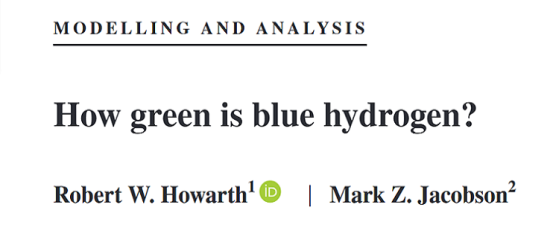論文:「ブルー水素」はどれくらい「グリーン」か(?)(How green is blue hydrogen?)by Robert W. Howarth/ Mark Z. Jacobson
2022-12-02 23:50:18

(日本語要旨)
水素は、将来の脱炭素世界において重要なエネルギーキャリアと見なされがちだ。現在、生産される水素の大半は、天然ガス中のメタンを原料とする水蒸気改質法で製造されるもの(グレー水素)で、二酸化炭素(CO2)排出量が多いことで知られる。現在は次第に、炭素の回収と貯蔵(CCS)を使用して水素製造工程からのCO2排出量を削減する、いわゆる「ブルー水素」についての多くの提案がされている。われわれはこのブルー水素から生じるCO2と未燃の漏洩メタンを計算し、同水素のライフサイクルベースでの温室効果ガス排出量を、査読付き論文としての最初の取り組みを開始する。
結論を言うと、ブルー水素の生産から生じる温室効果ガスの排出量は低炭素というレベルからは、ほど遠い。特に漏洩メタンの放出によって排出量は非常に高くなっている。われわれのデフォルトの仮定(天然ガスからのメタン排出率3.5%と、20年間の地球温暖化係数を前提)では、ブルー水素からのCO2換算の総排出量は、グレー水素よりもわずか9%〜12%少ないだけ。ブルー水素はグレー水素に比べ、CO2排出量は多少、少ないが、炭素回収貯留(CCS)装置を動かすための電力のために、天然ガスの使用が増えるため、グレー水素よりも、漏洩するメタン排出量は多くなる。
さらに驚くべきことに、ブルー水素の温室効果ガスのフットプリントは、天然ガスや石炭を熱供給のために燃やすよりも20%以上多く、ディーゼル油を熱供給のために燃やすよりも約60%も多い。天然ガスからのメタン排出率を1.54%という低い値に低減した感度分析では、ブルー水素からの温室効果ガス排出量は、天然ガスを単に燃焼させる場合よりも依然として多く、グレー水素よりも18%〜25%少ないだけだ。
われわれの分析では、CCSで回収されたCO2は無期限に貯蔵できると仮定しているが、これは楽観的で、まだ証明されていない仮定だ。しかし、たとえその仮定が本当だとしても、ブルー水素の使用を、気候対策上の理由で正当化するのは難しいようだ。
<Abstract>
Hydrogen is often viewed as an important energy carrier in a future decarbonized world. Currently, most hydrogen is produced by steam reforming of methane in natural gas (“gray hydrogen”), with high carbon dioxide emissions. Increasingly, many propose using carbon capture and storage to reduce these emissions, producing so-called “blue hydrogen,” frequently promoted as low emissions.
We undertake the first effort in a peer-reviewed paper to examine the lifecycle greenhouse gas emissions of blue hydrogen accounting for emissions of both carbon dioxide and unburned fugitive methane. Far from being low carbon, greenhouse gas emissions from the production of blue hydrogen are quite high, particularly due to the release of fugitive methane. For our default assumptions (3.5% emission rate of methane from natural gas and a 20-year global warming potential), total carbon dioxide equivalent emissions for blue hydrogen are only 9%-12% less than for gray hydrogen. While carbon dioxide emissions are lower, fugitive methane emissions for blue hydrogen are higher than for gray hydrogen because of an increased use of natural gas to power the carbon capture.
Perhaps surprisingly, the greenhouse gas footprint of blue hydrogen is more than 20% greater than burning natural gas or coal for heat and some 60% greater than burning diesel oil for heat, again with our default assumptions. In a sensitivity analysis in which the methane emission rate from natural gas is reduced to a low value of 1.54%, greenhouse gas emissions from blue hydrogen are still greater than from simply burning natural gas, and are only 18%-25% less than for gray hydrogen.
Our analysis assumes that captured carbon dioxide can be stored indefinitely, an optimistic and unproven assumption. Even if true though, the use of blue hydrogen appears difficult to justify on climate grounds.
//////////////////////////////////////////////////////////////////////
Robert W. Howarth:Department of Ecology & Evolutionary Biology, Cornell University, Ithaca, New York, USA
Mark Z. Jacobson:Department of Civil & Environmental Engineering, Stanford University, Stanford, California, USA
https://onlinelibrary.wiley.com/doi/full/10.1002/ese3.956
How green is blue hydrogen? – Howarth – 2021 – Energy Science & Engineering – Wiley Online Library


































 Research Institute for Environmental Finance
Research Institute for Environmental Finance